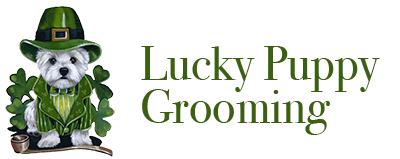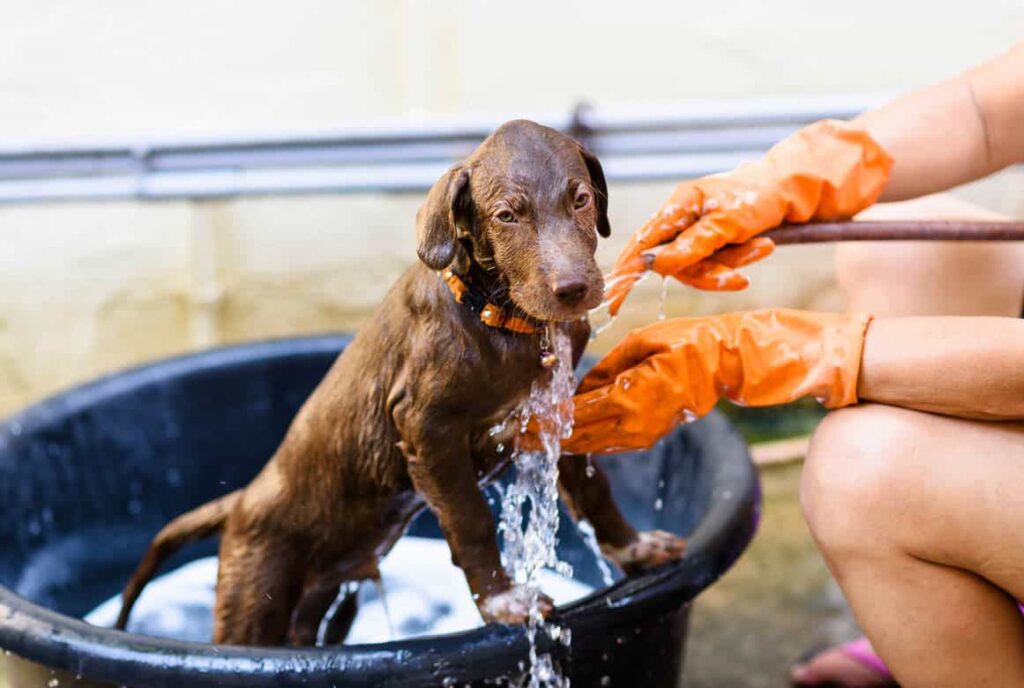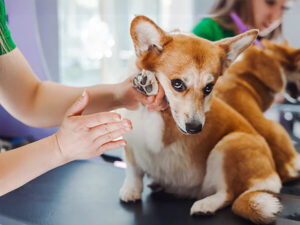Grooming your dog on a regular basis isn’t just about keeping them looking good. Dog grooming also helps promote good hygiene in your four-legged friend, and is even valuable in creating a bond between you and your dog. It’s the best way to spot potential problems in your pooch early on, and seek veterinary treatment that can prevent a minor nuisance from becoming a serious health concern. For all of these reasons, regular grooming sessions with your dog, one-on-one, are critical. Professional groomers can be used on occasion, but are no substitute for direct attention with your pet.
Despite all the benefits of grooming, many pet owners can be hesitant, and unsure how to approach even simple grooming tasks with their pet. Overly excitable or aggressive dogs may present particular challenges for owners. Nevertheless, it’s worth putting in the time and effort to get your dog used to grooming activities as much as you can. Starting slow and using treats are always the best approach. If you get frustrated or need to stop, that’s totally fine. The goal is to acclimatize your dog to the grooming process, and make them comfortable with what you are doing, so that it can be a positive experience for both of you. Of course, there’s a lot more specific advice for different aspects of dog grooming, which we’ll discuss below in our guide.
Dog Grooming 101: Bathing
Bathing your dog is one of the most basic ways to groom them and keep them clean. For most breeds, bathing is not required more than once every few months. Over-bathing can deplete critical oils from a dog’s skin and coat, leading to increased skin dryness, irritation, and skin conditions. However, if your dog finds their way into dirt or something smelly more frequently, then more frequent bathing or spot cleaning may be required.
- When bathing your dog, be sure to use a dog shampoo
rather than a human shampoo. Even baby
or “no tears” shampoos are not formulated for a dog’s coat, and can be too
harsh for dogs’ thinner-than-human skin. - Always use a non-slip surface for bathing your dog,
such as a bath mat if using a tub or kiddie pool, or a spare towel if bathing
in the sink or a smaller container for smaller dogs. - While you should always follow the instructions on
the shampoo, in general, the process is to wet their coat, lather the shampoo,
then rinse it out thoroughly. It’s
important to make sure it is rinsed clean, to avoid leaving any residue in
their coat that can irritate and leave their coat dull and less resilient. - Try to avoid getting shampoo and even clean water
directly in sensitive areas of your dog’s face, including their mouth, ears,
and eyes. - Drying your dog with a towel or hair dryer are both
acceptable options. If you use a hair
dryer, be sure it is on the lowest setting or only blowing air rather than in
heat mode, as dogs can overheat and their skin can be burned more easily than a
human’s.
Brushing
Brushing your dog’s hair regularly helps to remove dead strands and debris, ensures even distribution of the natural oils that keep a dog’s coat healthy, aids in the removal of dead or dry skin cells, and is the best way to perform regular surveillance of your dog for any potential insects, parasites, cuts, bruises, or other health conditions that may present there. Typically, regardless of the type of coat your dog may have, or its length, brushing should be done once every few days. If you notice knotted or matted hair, then you may need to brush more often or with special brushes – or even trim the hair somewhat, depending on what your dog has been up to or gotten in to. Most often, however, general-purpose brushing for maintenance and health every few days should be a sufficient baseline for dog grooming.
- Always be sure to choose the right type of brush for
the task and your breed. There are both
general-purpose brushes and specialized brushes, along with some meant more for
dense, short-coated dogs or longer, fluffier-coated dogs. - General brushing for most breeds can be best
accomplished with a comb-style brush or pin-head style brush. - Matted hair, undercoats, and similar should only be
dealt with using a brush intended for that purpose, such as a shedding blade or
slicker-style brush. - Before brushing your dog, let them examine the
brush, sniff it, and be aware of what it is so they are not startled. - Always brush away from your dog, “with the grain” of
their hair, starting at the base and moving outward. It reduces the risk of tangles or pulling
hairs, which is unpleasant for dog and owner alike. - Use treats copiously during the brushing session to
reinforce good behavior. - Don’t try to do too much at once, especially if your
dog is new to brushing. Start with short
sessions and increase the length as he or she takes to it over time.
Don’t Forget Foot Care
Foot care is an important aspect of grooming your dog, but is often overlooked until your pet presents a problem. Regular trimming of foot hair helps keep them clean, and prevents debris like dirt, rocks, bits of ice or snow, road salt, and other irritants from getting caught in their feet and injuring their paw pads.
- Grooming scissors are the best tool for the job,
allowing you to trim the hairs that grow on the tops of your dog’s feet, and
around the paw pads. - Do not trim in between the toes – just trim the hair
around the paw pads until it is approximately level with the paw pads. - Trimming in between toes can lead to bleeding and
injury, increasing the risk of irritation and infection.
The Importance of Nail Care
Cutting or clipping a dog’s nails is one of the more prickly grooming tasks for pet owners. Many prefer to leave this to vets or professionals, and rightly so – improper cutting can injure your pet. Dogs’ nails naturally grow in a curve shape, and if they get too long, that will result in awkward and improper steps for your dog. Their toes will twist and spread outward, and can even lead to broken toes, along with significant pain and discomfort. Clipping their nails helps prevent this from happening. It also helps prevent or reduce the incidence of torn, chipped, or damaged nails – not to mention reducing wear and tear on your home flooring and furnishings! Most breeds’ nails should be clipped every two or three weeks.
- Buy a nail clipper specifically meant for use on dogs. Don’t try to use a human nail clipper or scissors.
- The nail clipper you choose should feel comfortable and sturdy in your hand, and allow you to see exactly where the cutting action takes place. The blade should be sharp but protected inside the cutter.
- If you are worried about cutting too much and nicking the vein in your dog’s nail, known as the quick, you can buy styptic powder to use in that case, which acts as a clotting agent.
- As with brushing, let your dog sniff and inspect the clipper prior to use. Give it a few clips so they become acquainted with the noises before you try clipping any nails.
- Don’t go too quickly or try to do too much in one sitting. It may take several attempts to trim multiple nails depending on your dog’s demeanor.
- Always try to be positive and praise your dog, and reward them with treats.
- Clip small bits from the tip of the nail. If your dog has clear nails, you can see the vein, and don’t want to get too close to it. With dark nails, it’s best to clip a little bit, then inspect the nail where you just cut. If you see a pale oval shape near the tip after cutting, that’s where you should stop, as it means you are getting close to the vein.
- While not all breeds have dew claws, if yours does, don’t forget to clip them in a similar manner.
ALSO READ – Everything You Need to Know About Dog Shaving
Keeping Ears Clean and Healthy
Caring for your dog’s ears is essential to preventing ear infections and hearing loss. The ears and the area around the ears are also places that ticks and fleas love to congregate, so proper ear care can help you spot these nasty parasites and take care of them. Most experts recommend ear cleaning no more than once per week.
- Don’t ever use cotton swabs or other pointed objects
to clean the ears. This can damage the
ear canal and cause injury. - Use a cotton ball or piece of gauze. Special ear cleaning solution is ideal, and
sold at most pet stores. - Wrap the cotton or gauze around your finger, and
wipe down the surface of your dog’s ear.
Don’t push into the ear or apply much pressure – gentle cleaning in key. - If your dog is constantly itching their ears, or you
notice changes in the way their ears smell, or if your dog has a discharge from
the ears, you should have a vet look at them.
They may have an infection that requires antibiotics to clear.
Doggie Dental Care
One area where dogs and humans are remarkably similar is in the teeth. Dogs can develop many of the same kinds of dental problems that humans do with their teeth, including plaque, cavities, gum disease, and more. While proper diet and bones/chews can help to clean your dog’s teeth, there’s no substitute for a proper cleaning. It’s also one of the best ways to avoid unnecessary expenses and pain for your dog as they age. Most experts recommend cleaning your dog’s teeth two to three times per week.
- As with most dog grooming, you should start slow and
methodically. You may need to simply use
your finger to simulate brushing motions in your dog’s mouth, touching their
teeth and gums, before they will become used to the situation. Then, you can gradually move on to a cleaning
tool or brush meant for dogs. - Dog toothbrushes are available from most pet stores
and online. You can also use gauze
wrapped around the finger, or some finger-attaching scrubbing devices that are
also often available at pet stores and online. - Never use human toothpaste or mouthwash on your
dog. Both can cause upset stomachs and
other health problems for dogs. - Use toothpaste meant for dogs, baking soda, or even
just plain water. - It’s not necessary to clean all sides of a dog’s
teeth. Just the outer surfaces need
cleaning. The normal chewing and moving
of a dog’s tongue keep the inside and top surfaces of their teeth clean. - Be gentle – like brushing a child’s teeth, you don’t want to irritate your pet’s gums or cause tissue injury.
ALSO READ – Expert Grooming Advice for Your Pet Pupper





